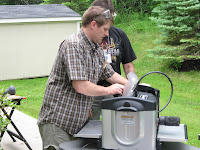Technology and Engineering Education - Gray New Gloucester Middle School
Transparency
My district is changing to performance based assessment. Step 4 of the Classroom Design and Delivery Model we are using is:
4. Develop transparency so students can navigate their own learning
- Identify desired learning
- Create a system to allow students to chart progress through standards
I
have already organized most of the Tech standards into units by grade
level and have developed tasks or activities for many of the standards. I
would like to present the standards and tasks for each unit in two
column charts and post the charts online for students to access.
For
a system that allows students to chart progress through standards, I
would like to use a system similar to the one demonstrated at the
digital portfolio workshop where students make a copy of the desired
learning chart and add links to their digitized work on the chart. Or I
may have the students submit their evidence in an online form. I will
have to learn more to set this up but the basic idea is that students
will digitize their work and submit and store it electronically.
Reverse Teaching
I
would like to have more how-to or informational videos for students
available online with perhaps a short follow up quiz to check
understanding of vocabulary, facts, steps, or procedures. I’m not sure
if I will assign these as homework because some students don’t have the
internet at home. However, having them available for students’
independent learning will free up time for project work and make it
easier for absent students to make up work.
The
videos will be posted in the same online venue as the unit charts. The
choice of online site depends on a few things. I will have to check if
Blogger is available at the school. I have a wikispaces site that seems
to work well at the school so that is a possibility. The district is now
using Google Apps but not all students had been assigned their accounts
at the end of the school year and I don’t know the status of doing this
school wide for the coming year.










